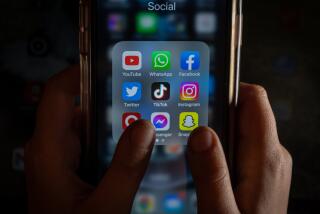Cell Phones and Driving a Lethal Mix, Study Says
- Share via
WASHINGTON — The death toll from crashes caused by drivers talking on their cell phones appears to be rising significantly as the devices become a must-have accessory for many Americans.
A study released today by Harvard University’s Center for Risk Analysis estimates a rate of 2,600 deaths a year in such crashes, compared to the same researchers’ estimate of 1,000 fatalities only two years ago.
“The amount of time people spend using their cell phones while driving has increased, probably reflecting the fact that it is becoming cheaper to use the devices,” said research scientist Joshua Cohen, the study’s author.
The Harvard study also estimated that 570,000 injuries a year and 1.5 million property damage crashes can be blamed on cell phone use.
Last year in California, at least 4,699 reported accidents were blamed on drivers using cell phones, and those crashes killed 31 people and injured 2,786, according to a recent analysis by The Times. CHP Commissioner Dwight O. “Spike” Hemlick has reversed a previous stance against restrictions and now says he will back legislation requiring California motorists to use only hands-free cell phones.
Nationally, the Harvard study will feed into a debate that pits personal freedom and convenience against safety concerns. Two federal agencies have recently stepped up efforts to understand how cell phone use may contribute to accidents. The National Transportation Safety Board is investigating cell phones as a potential contributing factor in several recent serious crashes. The National Highway Traffic Safety Administration is launching a study of how cell phone use affects individual drivers, using the government’s driving simulator facility in Iowa.
Nationwide, there is no uniform measure for tracking accidents in which cell phone use may have been a factor.
The Harvard study used mathematical models to estimate the risk of injury and death as well as the costs and benefits of using cell phones while driving. The risk analysis center is part of Harvard’s School of Public Health.
In a key finding for policymakers, the study concluded that the escalating costs of cell phone-related accidents are erasing the economic benefits of unrestricted use of the devices by drivers.
Previous economic analysis by Harvard researchers had found that the benefits of being able to readily communicate for business or pleasure while on the road clearly outweighed the social costs of injuries and deaths in accidents.
Cohen’s latest calculations found that the costs are now roughly equal to the benefits.
“The risk is growing, but the benefits are not keeping up,” Cohen said. Such conclusions could bolster the case for restricting cell phone use by drivers.
This year, at least 22 states considered legislation to restrict cell phone use while driving, according to the Insurance Institute for Highway Safety.
So far, only New York has enacted a partial prohibition. It does not allow drivers to use hand-held phones. New Yorkers may use devices adapted for hands-free use, which are usu- ally voice-activated and come with an earpiece and microphone.
It is too early to tell whether New York’s law, which went into effect last year, is saving lives. A preliminary study indicated that the law has changed the behavior of motorists, and that use of hand-held phones appears to be down by about 50%.
Cell phone use is by no means the biggest menace on the roads. Alcohol-related crashes accounted for 17,448 deaths last year, while accidents involving speeding took 12,850 lives, according to federal statistics.
But much less is known about the link between cell phone use and crashes than about the effects of alcohol or speeding. In most states, accident report forms used by police do not collect information on whether drivers were on the phone.
The cell phone industry -- which has more than 128 million customers -- has refused to turn over customer records that would allow researchers to pinpoint whether drivers were in fact on the phone at the time of an accident.
A 1997 study of Canadian drivers who agreed to have their cell phone records scrutinized found that the risk of an accident was four times greater while a driver was using the phone.
Similar research needs to be done in the U.S., said Russ Rader, an insurance safety institute spokesman. “Intuitively, you know there has to be some sort of risk there,” he said. “There has to be an element of distraction. But how great a risk that is has not been nailed down.”
Cohen, the author of the Harvard study, said federal and state agencies should commission more research before any decision to restrict cell phone use. That way, lawmakers can be sure that the solutions they come up with will work.
Although New York’s ban on hand-held phones has generated widespread interest, Cohen said research indicates it might not be the most effective approach. The Canadian study found that hands-free phones did not appear to reduce the risk of getting into an accident. Crashes “may result from drivers’ limitations with regard to attention rather than dexterity,” the Canadian authors suggested.
“We don’t have the data to make the best policy we need to make,” Cohen said.
The cell phone industry strongly opposes restrictions on motorists, but it has launched a safety education campaign that discourages drivers from engaging in stressful conversations while behind the wheel, and urges them to avoid using their phones in bad weather, heavy traffic or while driving in unfamiliar territory. The industry encourages the use of hands-free phones.
“There are laws already in place that allow an officer to stop and ticket a driver for distracted driving,” said Kim Kuo, a spokeswoman for the Cellular Telecommunications and Internet Assn. “We feel it’s going to be ineffective if you just pass laws and ignore the need for education.”
But Cohen said there are social implications to irresponsible cell phone habits that may have to be addressed by lawmakers. The motorist talking on the phone is not the only one who can get hurt in a crash. Occupants of other vehicles and pedestrians are also at risk.
“We have a public health issue that needs to be looked at carefully,” Cohen said.






